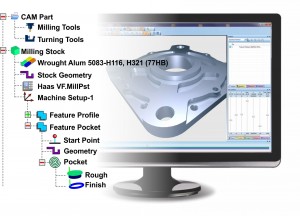This is part three of a ongoing series on improving cnc programming worflow with CAD-CAM software. For the previous section, click here and to start with part one, please click here.
Once the part file is ready to move into the toolpath and programming stage you will find that most CAM (Computer Aided Manufacturing) software products provide a standard “Job Tree” method of organizing machining strategies into a productive workflow so that tools can be added, toolpath strategies can be used and a program can be created in its proper sequence.
 The “Tree” organizes everything, allows you to turn machining operations on and off, re-order operations, post process and basically manage everything about the job program right within the software interface. So what would be the optimum order of production in this stage of the workflow process? The first things to be done would be the creation of the Stock for your part so that a Machine Setup – work coordinate can be created, then what your material and tools being used as this affects the speed and feed settings within cnc toolpath strategies. This is where a CAD/CAM system can improve efficiency in your workflow by adding a Stock Wizard that steps you through the process of creating your stock. This includes offering a full material library that can be customized and added to as needed.
The “Tree” organizes everything, allows you to turn machining operations on and off, re-order operations, post process and basically manage everything about the job program right within the software interface. So what would be the optimum order of production in this stage of the workflow process? The first things to be done would be the creation of the Stock for your part so that a Machine Setup – work coordinate can be created, then what your material and tools being used as this affects the speed and feed settings within cnc toolpath strategies. This is where a CAD/CAM system can improve efficiency in your workflow by adding a Stock Wizard that steps you through the process of creating your stock. This includes offering a full material library that can be customized and added to as needed.
Workflow improvements also take place in the ability to easily access and setup your Cutting Conditions and Tool Patterns (Multi-Tool operations such as a counter bore or hole drilling with a center drill, drill and possibly a chamfer), Tool Crib and Tool Holder data. All of this is important to creating a error free NC Program. Lastly, you will need to access a tool library for all of your tools. Rather than to talk about the types of tools we will just say, the more the better for all applications.
However the tool library should include all tool data, material, diameter, angle, length, label and more that you will be using for all machining strategies within the job tree manager. All of this information makes the process of setting up a job faster if the process is Wizard driven or if you have the ability to save set up details globally or separately from job to job. Another effective feature for saving time is the ability to save and load machine features. Many shops do a lot of the same types of jobs.
If you have already setup your CAM for one job and can use that setup for another similar job then you can just open the configuration and begin creating toolpath or at least not have to do so much setup. The idea here is “automation” so every opportunity to increase efficiency counts.
Part of creating and setting up your stock is the Machine Setup. The machine setup is part of the process and CAM software allows you to select an origin or create one by using X, Y and Z coordinates. You may also select an existing User Coordinate System (UCS) and also create a work offset for the program.
The Machine Setup should be located within the Job Tree – Job Manager and give you the ability to edit it later, choose what machining operations you want to use (from 2, 3, 4 and 5 axis axis machining), add an index for 4th axis machining, load previously saved machining features and more. You should even be able to insert other Machine Setups with different Work Offsets. These software capabilities will positively affect the efficiency of your workflow when made available in an easy to understand and use interface.
Once you have set up the stock, tools, material and cutting conditions you want to set up the post processor for your job. The post processor is the translator used in the process of converting the setup data and toolpath data and creating a numeric language (G-Code) then you will send to the machine tools controller to physically machine the part. Most CNC Software systems offer post processors. Some offer the ability to customize a post processor so that it meets the requirements of the controller on the machine. Check with the software provider for a library of post configuration files, particularly the one for your specific machine tool. While this is one of the biggest topics of CAD/CAM software and why CAD/CAM even exists, Workflow efficiency can be achieved just by having the software provider assist you in the creation or modification of posts. A correct post processor eliminates the need for you to have to hand edit code. Thus, allowing you to spend your time focusing on the machining side of it all.
In part four, we will discuss toolpath and machining strategies.



Leave a Reply